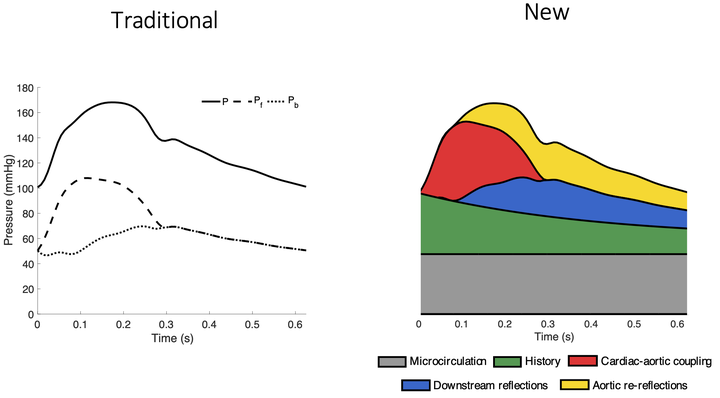Novel Pressure Wave Separation Analysis for Cardiovascular Function Assessment Highlights Major Role of Aortic Root
 Image credit: S. Vennin et al. (CC BY 4.0)
Image credit: S. Vennin et al. (CC BY 4.0)
Abstract
Objective: A novel method was presented to separate the central blood pressure wave (CBPW) into five components with different biophysical and temporal origins. It includes a time-varying emission coefficient (λ) that quantifies pulse wave generation and reflection at the aortic root. Methods: The method was applied to normotensive subjects with modulated physiology by inotropic/vasoactive drugs (n=13), hypertensive subjects (n=158), and virtual subjects (n=4,374). Results: λ is directly proportional to aortic flow throughout the cardiac cycle. Mean peak λ increased with increasing pulse pressure (from <30 to >70 mmHg) in the hypertensive (from 1.6 to 2.5, P<0.001) and in silico (from 1.4 to 2.8, P<0.001) groups, dobutamine dose (from baseline to 7.5 μg/kg/min) in the normotensive group (from 2.1 to 2.7, P<0.05), and remained unchanged when peripheral wave reflections were suppressed in silico. This was accompanied by an increase in the percentage contribution of the cardiac-aortic-coupling component of CBPW in systole: from 11% to 23% (P<0.001) in the hypertensive group, 9% to 21% (P<0.001) in the in silico group, and 17% to 23% (P<0.01) in the normotensive group. Conclusion: These results suggest that the aortic root is a major reflection site in the systemic arterial network and ventricular-aortic coupling is the main determinant in the elevation of pulsatile pulse pressure. Significance: Ventricular-aortic coupling is a prime therapeutic target for preventing/treating systolic hypertension.